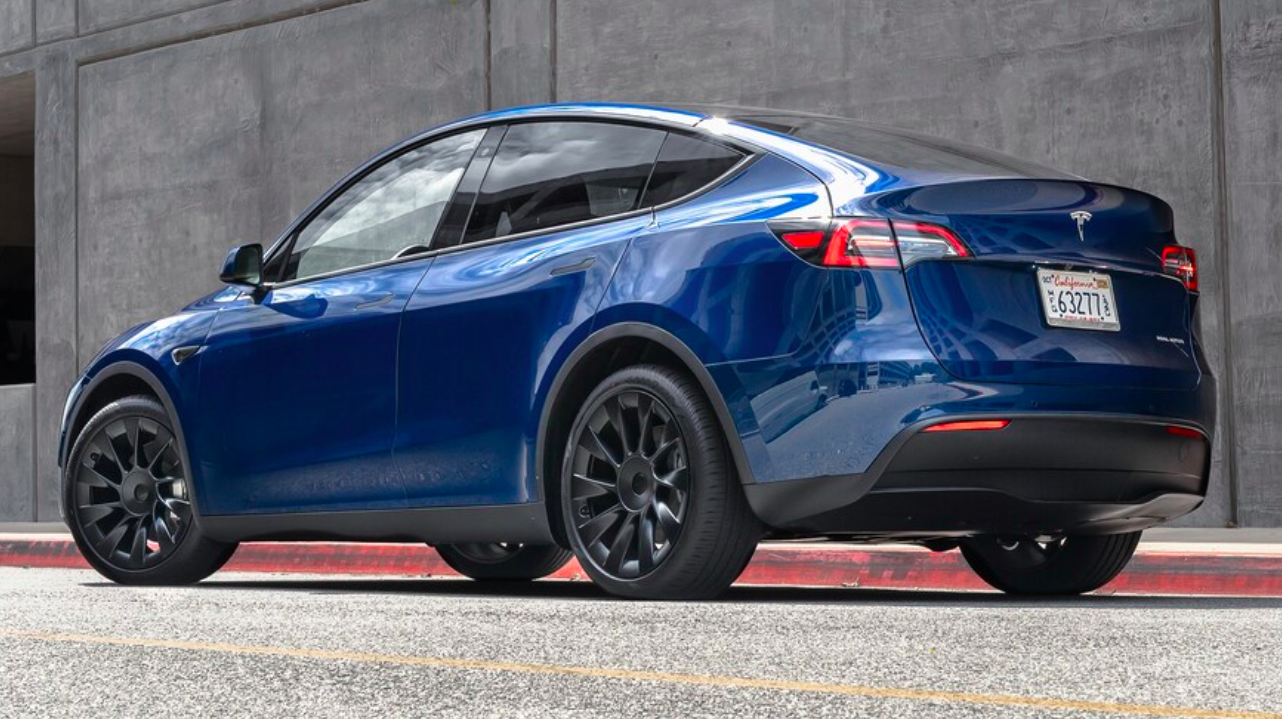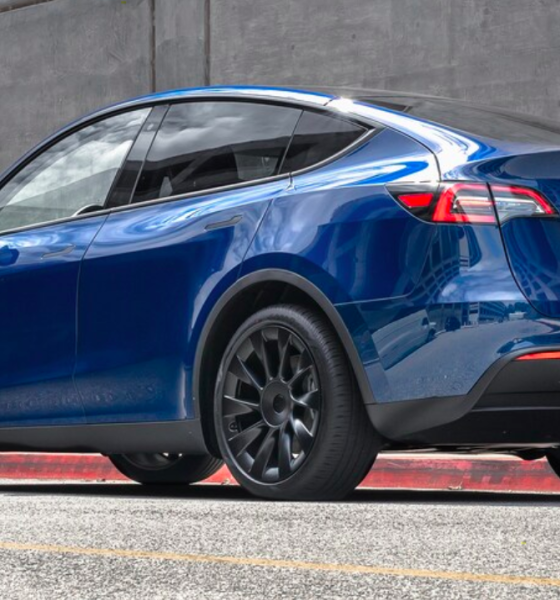

News
Chevy’s big US win bodes well for the Tesla Model Y’s potential domination
The United States’ auto market may be reeling hard due to the ongoing pandemic, but there are still vehicles that are proving successful even in these trying times. One of these is the 2021 Chevy Trailblazer, which currently stands as the country’s fastest-selling new car. These results, especially considering the ongoing outbreak, bodes well for the Tesla Model Y and its potential domination of the premium crossover market.
According to a recent study from car search engine iSeeCars.com, the 2021 Chevy Trailblazer is the United States’ fastest-selling new car, spending only an average of 19 days on dealer lots before being sold. This is extremely impressive, especially considering that the study revealed that the average new car spends a whopping 97 days for sale before being bought.
In a way, the 2021 Chevy Trailblazer’s impressive rankings among the United States’ new car sales suggest that the crossover SUV market is alive and well, even in the midst of a pandemic. The 2021 Trailblazer, after all, is a subcompact SUV that represents pretty much what is expected of the crossover segment. It’s reasonably priced, practical, and it has a pretty hefty amount of features. These are things that the Model Y also excels in, albeit at a more premium price point.
The Tesla Model Y is arguably the electric car maker’s most bang-for-your-buck vehicle so far, being priced close to the Model 3 yet featuring utility that’s closer to the far more expensive Model X. Considering that crossovers remain popular, it appears that the Model Y could still find a good foothold in the US this year. This could benefit Tesla, especially since the Model Y already proved profitable in its first quarter of production despite the vehicle not being fully ramped. Tesla CFO Zachary Kirkhorn discussed this in the company’s Q2 2020 earnings call.
“Model Y, as we mentioned last quarter, was profitable in its first quarter of production. And despite the inefficiencies that we had due to the shutdown, we did see a pretty substantial improvement in the Model Y margin. And as we said before, the Model Y cost structure and Model 3 cost structure will converge. They’re not quite there. Model Y is still slightly more expensive than Model 3, and it’s not yet at full production. And with Model Y carrying a slightly higher price point, you can kind of back into the math there on the relative gross margins,” he said.
One thing that truly bodes well for the Model Y’s chances in the US’ new auto market is the fact that it is arguably one of the best premium crossovers in the market today, electric or otherwise. The vehicle has seen stellar reviews from noted veterans such as teardowns specialist Sandy Munro, and though the Model Y still has several areas of improvement, it appears that the crossover is well on its way to joining its sibling, the Model 3, as one of Tesla’s best-selling electric cars.
The Model 3, after all, has met its own set of doubters during its initial release, with Tesla critics insisting that the vehicle will not find a foothold in the midsize sedan market. Despite this, Model 3 demand proved stable enough that the vehicle practically dominated Tesla’s sales numbers in previous years, all the while beating cars like the BMW M3 in the US. Part of this is likely due to the Model 3’s uniqueness in the market. After all, very few vehicles could offer as much tech and performance at its price point. The same will likely be true for the Model Y.

News
Elon Musk’s Grokipedia surges to 5.6M articles, almost 79% of English Wikipedia
The explosive growth marks a major milestone for the AI-powered online encyclopedia, which was launched by Elon Musk’s xAI just months ago.

Elon Musk’s Grokipedia has grown to an impressive 5,615,201 articles as of today, closing in on 79% of the English Wikipedia’s current total of 7,119,376 articles.
The explosive growth marks a major milestone for the AI-powered online encyclopedia, which was launched by Elon Musk’s xAI just months ago. Needless to say, it would only be a matter of time before Grokipedia exceeds English Wikipedia in sheer volume.
Grokipedia’s rapid growth
xAI’s vision for Grokipedia emphasizes neutrality, while Grok’s reasoning capabilities allow for fast drafting and fact-checking. When Elon Musk announced the initiative in late September 2025, he noted that Grokipedia would be an improvement to Wikipedia because it would be designed to avoid bias.
At the time, Musk noted that Grokipedia “is a necessary step towards the xAI goal of understanding the Universe.”
Grokipedia was launched in late October, and while xAI was careful to list it only as Version 0.1 at the time, the online encyclopedia immediately earned praise. Wikipedia co-founder Larry Sanger highlighted the project’s innovative approach, noting how it leverages AI to fill knowledge gaps and enable rapid updates. Netizens also observed how Grokipedia tends to present articles in a more objective manner compared to Wikipedia, which is edited by humans.
Elon Musk’s ambitious plans
With 5,615,201 total articles, Grokipedia has now grown to almost 79% of English Wikipedia’s article base. This is incredibly quick, though Grokipedia remains text-only for now. xAI, for its part, has now updated the online encyclopedia’s iteration to v0.2.
Elon Musk has shared bold ideas for Grokipedia, including sending a record of the entire knowledge base to space as part of xAI’s mission to preserve and expand human understanding. At some point, Musk stated that Grokipedia will be renamed to Encyclopedia Galactica, and it will be sent to the cosmos.
“When Grokipedia is good enough (long way to go), we will change the name to Encyclopedia Galactica. It will be an open source distillation of all knowledge, including audio, images and video. Join xAI to help build the sci-fi version of the Library of Alexandria!” Musk wrote, adding in a later post that “Copies will be etched in stone and sent to the Moon, Mars and beyond. This time, it will not be lost.”
News
Tesla Model 3 becomes Netherlands’ best-selling used EV in 2025
More than one in ten second-hand electric cars sold in the country last year was a Tesla Model 3.

The Tesla Model 3 became the most popular used electric car in the Netherlands in 2025, cementing its dominance well beyond the country’s new-car market.
After years at the top of Dutch EV sales charts, the Model 3 now leads the country’s second-hand EV market by a wide margin, as record used-car purchases pushed electric vehicles further into the mainstream.
Model 3 takes a commanding lead
The Netherlands recorded more than 2.1 million used car sales last year, the highest level on record. Of those, roughly 4.8%, or about 102,000 vehicles, were electric. Within that growing segment, the Tesla Model 3 stood far ahead of its competitors.
In 2025 alone, 11,338 used Model 3s changed hands, giving the car an 11.1% share of the country’s entire used EV market. That means more than one in ten second-hand electric cars sold in the country last year was a Tesla Model 3, Auto Week Netherlands reported. The scale of its lead is striking: the gap between the Model 3 and the second-place finisher, the Volkswagen ID3, is more than 6,700 vehicles.
Rivals trail as residual values shape rankings
The Volkswagen ID.3 ranked a distant second, with 4,595 used units sold and a 4.5% market share. Close behind was the Audi e-tron, which placed third with 4,236 registrations. As noted by Auto Week Netherlands, relatively low residual values likely boosted the e-tron’s appeal in the used market, despite its higher original price.
Other strong performers included the Kia Niro, the Tesla Model Y, and the Hyundai Kona, highlighting continued demand for compact and midsize electric vehicles with proven range and reliability. No other model, however, came close to matching the Model 3’s scale or market presence.
News
Tesla Model Y Standard Long Range RWD launches in Europe
The update was announced by Tesla Europe & Middle East in a post on its official social media account on X.

Tesla has expanded the Model Y lineup in Europe with the introduction of the Standard Long Range RWD variant, which offers an impressive 657 km of WLTP range.
The update was announced by Tesla Europe & Middle East in a post on its official social media account on X.
Model Y Standard Long Range RWD Details
Tesla Europe & Middle East highlighted some of the Model Y Standard Long Range RWD’s most notable specs, from its 657 km of WLTP range to its 2,118 liters of cargo volume. More importantly, Tesla also noted that the newly released variant only consumes 12.7 kWh per 100 km, making it the most efficient Model Y to date.
The Model Y Standard provides a lower entry point for consumers who wish to enter the Tesla ecosystem at the lowest possible price. While the Model 3 Standard is still more affordable, some consumers might prefer the Model Y Standard due to its larger size and crossover form factor. The fact that the Model Y Standard is equipped with Tesla’s AI4 computer also makes it ready for FSD’s eventual rollout to the region.
Top Gear’s Model Y Standard review
Top Gear‘s recent review of the Tesla Model Y Standard highlighted some of the vehicle’s most notable features, such as its impressive real-world range, stellar infotainment system, and spacious interior. As per the publication, the Model Y Standard still retains a lot of what makes Tesla’s vehicles well-rounded, even if it’s been equipped with a simplified interior.
Top Gear compared the Model Y Standard to its rivals in the same segment. “The introduction of the Standard trim brings the Model Y in line with the entry price of most of its closest competition. In fact, it’s actually cheaper than a Peugeot e-3008 and costs £5k less than an entry-level Audi Q4 e-tron. It also makes the Ford Mustang Mach-E look a little short with its higher entry price and worse range,” the publication wrote.








